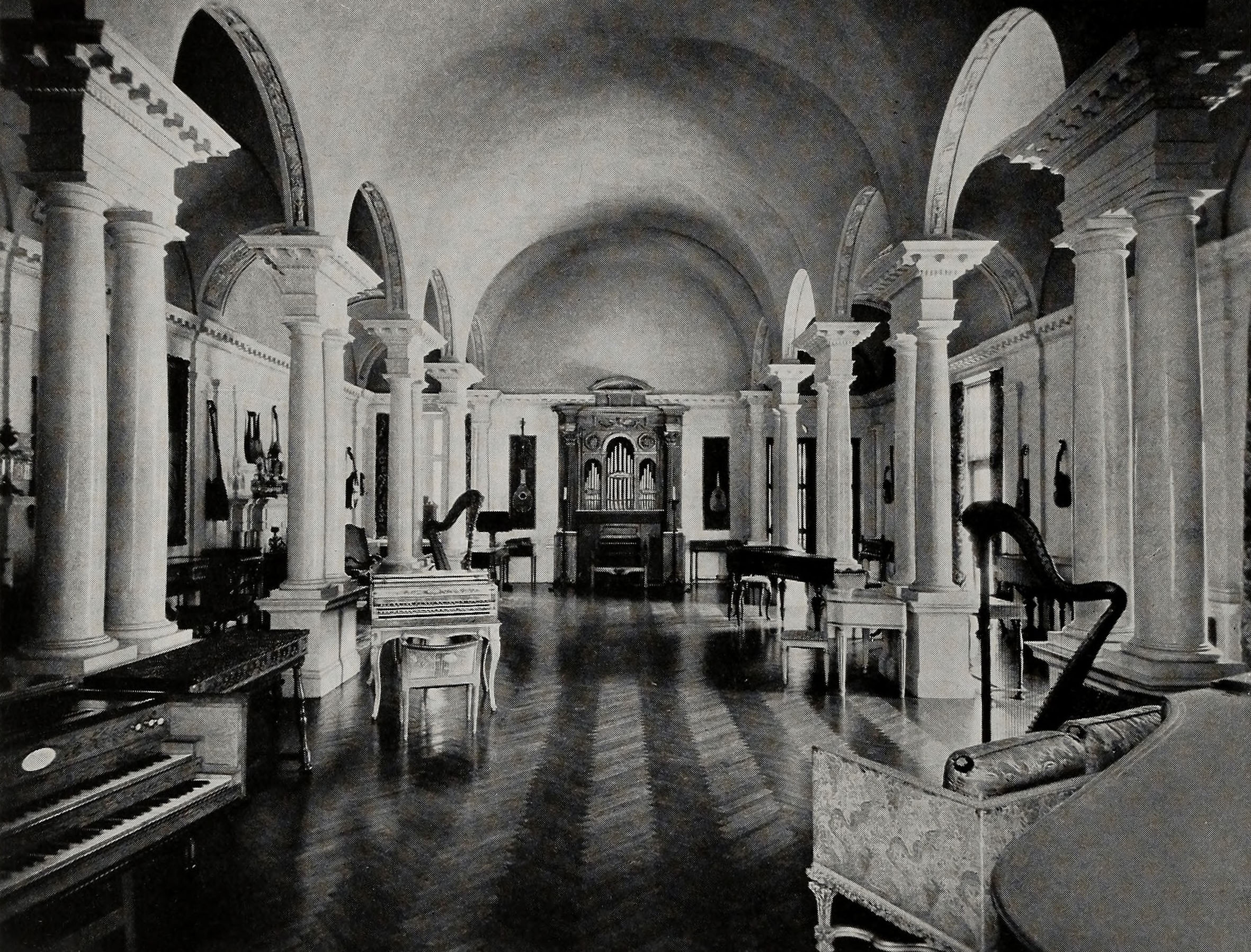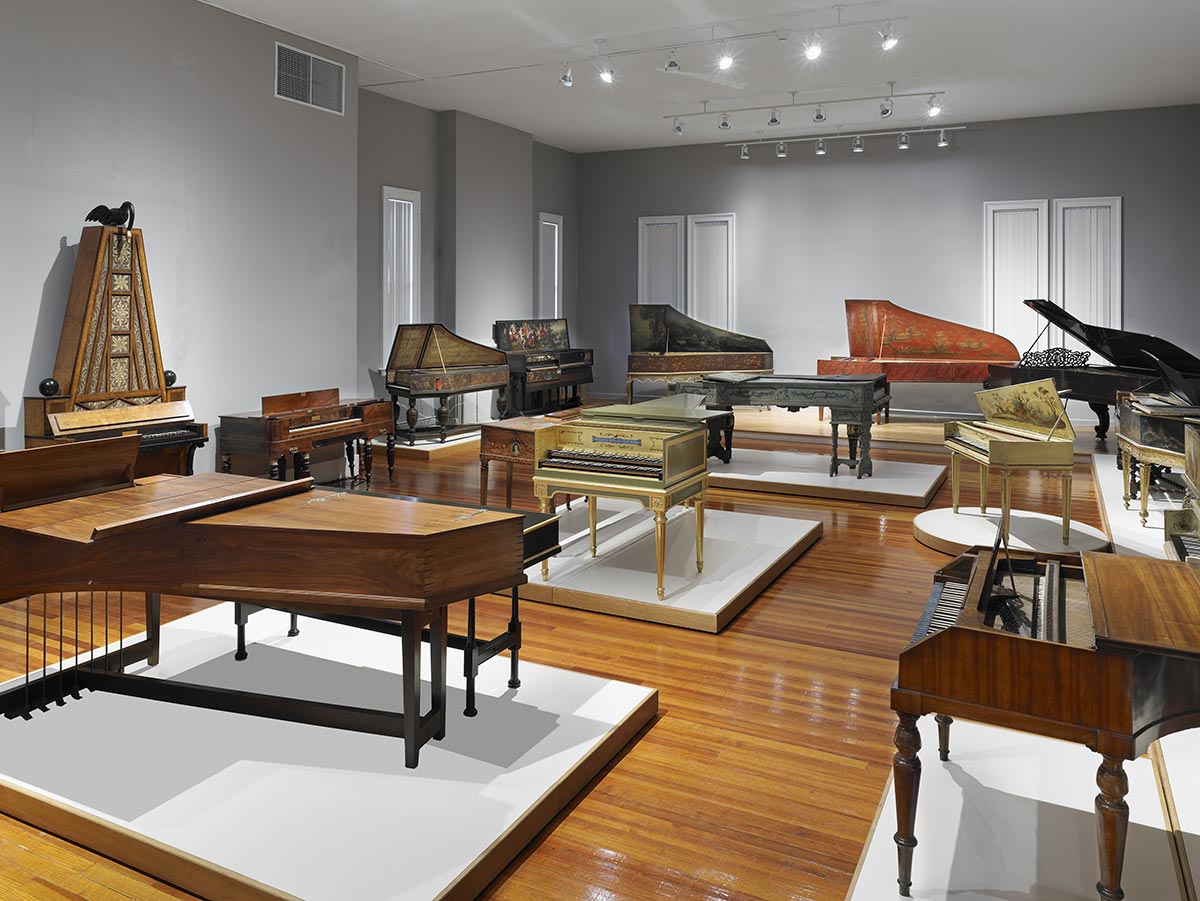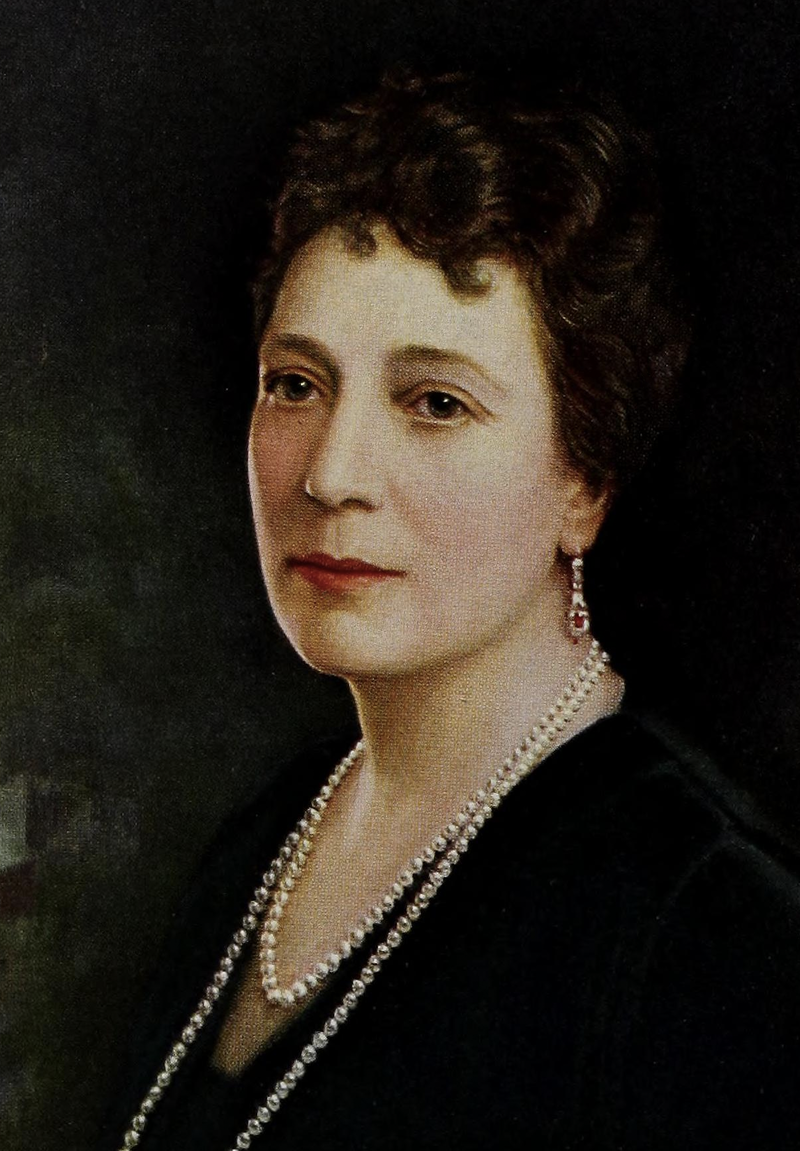The Belle Skinner Collection of Musical Instruments: Sixty years at Yale
With insight and endeavor she sought for the treasures in [her] collection. She chose only the best; sham or imitation she would never tolerate in anything… Fanny Reed Hammond (W. Skinner 1933, vii)
Ruth Isabel (“Belle”) Skinner (1866–1928) was an American humanitarian, philanthropist, women’s rights advocate, and instrument collector. A daughter of William Skinner and his second wife Sarah Elizabeth Allen, she received a privileged upbringing in Williamsburg and Holyoke, Massachusetts, where her father owned lucrative silk and satin mills. It is not exactly clear when Belle undertook the study of music, but it is likely that from an early age she was encouraged to develop an appreciation for the arts, perhaps studying piano, violin, and dance with local instructors.
In 1881, she entered the Vassar Preparatory School in Poughkeepsie, New York. Two years later, she matriculated at Vassar College, where music became her major course of study. Graduating in 1887, she received the degree of B.Mus. (Bachelor of Music).
Vassar’s Music Department was well-structured. Students could pursue the study of organ, piano, violin, and voice privately and take courses in The Origin of Musical Instruments, Ancient and Classical Chamber Music for Stringed Instruments, and Ancient Harpsichord and Classical Piano-forte Music, just to name a few. Interestingly, music courses were offered in the college’s art museum rather than in its traditional classroom building, the noise associated with music-making no doubt being a factor. Could it be that Belle’s frequent exposure to museum displays as a college student would provide her with the impetus to form a museum collection of her own later in life – a collection of rare and precious musical instruments?
Cultural Appreciation
As a young woman, Belle traveled the world, often in conjunction with family trips on business related to the silk industry. While these trips no doubt appealed to her spirit of adventure, they also served to acquaint her with the foundations and cultural manifestations of Western civilization.
During the summer, the Skinner family sometimes vacationed in Sharon Springs, New York. Here they may have encountered the piano entrepreneur Morris Steinert, who often presented lectures about the history of keyboard instruments during his family’s stays there. Steinert maintained a comprehensive collection of antique keyboard and stringed instruments at his home in New Haven that by 1893 had gained international recognition. His collection, as well as that of Mrs. Mary Elizabeth Adams Brown, a noted New York collector, could well have attracted Belle’s attention and even stimulated her own enthusiasm for collecting. (Mrs. Brown offered her collection to the Metropolitan Museum of Art in 1889. Over time, she donated roughly 3,600 instruments of which a large number were non-Western in origin.)
Belle was not an overly passionate collector who rushed to build her collection. Rather, she carefully sought instruments that satisfied her tastes in music and art, selectively choosing pieces that had both musical value and decorative merit. In the words of her brother, Will, “she delighted [in having] beautiful things near her. (...) Never did she intend to form a museum, but she was happy in the thought of bringing to her home treasures which she could share with her family and her friends and which she could leave to posterity” (W. Skinner 1933, ix).
Belle’s many trips to Europe enabled her to connect with dealers of antiquities who assisted her in identifying items of interest. At first, she seemed to favor keyboard instruments. When, in 1906, she heard about the availability of a double-manual harpsichord attributed to the celebrated Flemish builder Hans Ruckers (c. 1555–1623), she quickly decided that it was a “must-have” and several paintings, and a small assortment of manuscripts, went after it with gusto. Next came a rectangular, four-octave spinet of Italian or French origin made c. 1730, which has an interior lid painting suggestive of the Dutch school. These two instruments, along with an elegant square piano already in the Skinner family’s possession, became the foundation of her collection. Built c. 1810 by Alpheus Babcock of Boston, this particular piano with its soft tone and responsive action is likely to have played a fundamental role in Belle’s musical development during earlier years.

Collection Growth
As Belle’s collection grew in size, it also grew in reputation. Newspapers around the country carried snippets, even lengthy articles, praising its uniqueness and quality. A snippet in The Pittsburgh Press (Pittsburgh, Pennsylvania) of July 11, 1907, reads:
Miss Isabel Skinner, of Holyoke, Mass., has one of the finest private collections of musical instruments in the country. Many of them she secured in the old world, and she has had them all repaired and put in good playing condition…
Realizing that more space was needed to house her instruments, Belle commissioned the New York architect Clarence Sumner Luce to design an addition to Wistariahurst (the family mansion at Holyoke) that could serve as a music room. Constructed in 1913, this large room with high ceilings, parquet floors, Doric columns, and fine acoustics served as an elegant space for her to display and present in performance her gradually expanding collection.
From the earliest of her collecting days until her untimely death from pneumonia in 1928, she amassed 89 instruments, books, and music having to do with music-related subjects of the sixteenth through the nineteenth centuries. Highlights include a violin by Antonio Stradivari, Cremona, 1736; a guitar with ivory and tortoise-shell inlay by Joachim Tielke, Hamburg, 1702; a theorbo-lute by Sebastian Schelle, Nuremburg, 1726; a lyre guitar by Jean Charles, Marseille, 1785; an épinette by Pascal Taskin, Paris, 1778; a single manual harpsichord by Andreas Ruckers, Antwerp, 1640; a double-manual harpsichord by Johann Adolph Hass, Hamburg, 1760–1761; a Russian bassoon, the painted bell in the form of a serpent’s head, by Fratelli Garignani, Milan, c. 1820; and an Indian vina in the shape of a peacock, which technically can be referred to as a mayuri vina or veena (‘mayuri’ being the Sanskrit word for peahen, the feminine form of peacock).
In the grand scheme of things, Belle was considerably more than a collector of musical instruments. As Penni Martorell, Curator and City Historian, Wistariahurst, Holyoke, has observed: “It was Belle who designed many of the distinctive architectural, landscape, and design elements at [the Skinners’ home], including a room ‘papered’ in hand-painted leather, a driveway paved with dinosaur fossils, and a renowned music room. She was a world traveler and is still remembered today for her charitable projects at home and abroad.”
Of her many philanthropic endeavors, that of supporting the restoration of the medieval village of Hattonchâtel in northeastern France following World War I is probably best known. For her dedicated efforts in adopting the town and actively taking part in its reconstruction, she was decorated by the French government with the Médaille de la Reconnaissance française in 1919 and awarded the cross of a Chevalier de la Légion d’Honneur by the Consul General of France in 1921.
Preservation of the Collection: 1928–1959
Following Miss Skinner’s death in April 1928, her brother William C. Skinner supervised the publishing of a handsomely illustrated catalog of her collection (The Belle Skinner Collection of Old Musical Instruments, 1933). Care of her instruments fell to Nils Ericsson, who had served as repairer and curator of the instruments since 1923. Upon Mr. Ericsson’s death in 1933, Fanny Reed Hammond, wife of the well-known organist William Churchill Hammond, became curator. Mrs. Hammond, who was not only a local resident but also a trained keyboard player, cared for the collection until it was deposited at Yale some 26 years later.
During her tenure, Mrs. Hammond welcomed many social clubs, college groups, and musicians to Wistariahurst, including Serge Koussevitsky, conductor of the Boston Symphony Orchestra, who is said to have described the instruments in the music room as “a collection of superlatives.” To bring the sounds of the instruments to the public, Fanny collaborated with Belle’s niece, Elizabeth Kilborne Hudnut, in the production of two recordings, which were produced in the late 1950s as 33 1/3 discs.
By 1958, Katharine Skinner Kilborne and her three children had made the decision to donate the family mansion to the city of Holyoke for use as a museum and cultural center. Katharine was Belle’s younger sister and the last of her generation to inhabit Wistariahurst. Her children – Robert Stewart Kilborne, Jr., Elizabeth Kilborne Hudnut, and William Skinner Kilborne – were by that time middle-aged adults with families of their own who had long made their homes in towns geographically distant from Holyoke. As such, none of the three was interested in taking up residence at Wistariahurst. While considering Katharine’s move from the mansion, the question became: What shall we do with Belle’s collection of musical instruments?
Transfer to Yale
Enter Sybil Marcuse, curator of the Yale Collection of Musical Instruments, who was acquainted with the Skinner Collection both by sight and reputation. Miss Marcuse was well versed in the history of music as well as in the care and maintenance of keyboard instruments. She was keen to acquire Belle’s collection for Yale and moved quickly to convince her colleagues of its quality and potential value as an educational resource.
At the time, Yale’s historical instruments were kept in a third-floor room under the dome of Woolsey Hall, a spot where pigeons were prone to roost. Most of the instruments that were housed there had been donated in 1900 by Morris Steinert, the piano dealer and antique instrument collector mentioned earlier in this essay. Because the Steinert collection was tucked away under the dome, it was difficult to access and susceptible to ornithic damage. Sybil knew that the Skinner family would never consent to placing Belle’s collection there. Better quarters would have to be found.
Serendipitously, a number of fraternity houses on campus were in the process of closing. Sybil’s aim was to identify one that was empty and had a large gallery or two where keyboard instruments could be displayed and heard in concert. When she learned that a building on Hillhouse Avenue meeting her criteria was vacant, she moved into action. No. 15 had recently been the home of Yale’s chapter of the Chi Phi fraternity. A red limestone building with a Renaissance Revival, Richardsonian- style façade, it had ‘that museum look’ about it. Moreover, it boasted a large, spacious room with a lively acoustic that was perfect for the display and public presentation of antique keyboard instruments.

The Kilborne family was impressed with the possibility of moving Belle’s collection to Yale. Both of Katharine’s sons had attended the University and were strongly in favor of placing it there – R. Stewart having attended from 1923–1925; William, having graduated with the Class of 1935. The prospect of transferring the collection to a proper home on the campus of a major university appealed to virtually all concerned.
Sybil’s colleagues supported the move as well, and, after some negotiation, the bulk of the collection was moved to New Haven in 1959, where it was considered on loan to the University until final papers could be drawn. Discussions for its official transfer would continue until September 1960, when the University agreed to purchase 68 instruments and 3 paintings for a sum of $47,000 from Belle’s heirs – R. Stewart Kilborne, Elizabeth Kilborne Hudnut, and William Skinner Kilborne. Another 38 instruments and 3 paintings, plus books, manuscripts, and miscellaneous objects, were formally accessioned in April 1961 as a gift from Katharine Skinner Kilborne.
Two organizations on campus – The Friends of Music at Yale and the Yale University Art Gallery Associates – had supported Sybil from the beginning in her quest to acquire the collection. Not only did they assist her in obtaining the building at 15 Hillhouse Avenue, but they also raised funds to satisfy the younger Skinners’ purchase price.
Inaugural Exhibition in 1960
As enthusiasm for the acquisition grew, plans were made to exhibit some of the Skinner instruments along with some of Yale’s existing holdings from The Steinert Collection, the University of Pennsylvania, and private donors. In this way, the merging of the different collections was emphasized. Responsibility for the exhibition’s organization fell to Miss Marcuse, who quickly became engaged in selecting instruments for the show and producing a catalog. Stanton L. Catlin, Assistant Director of the Yale University Art Gallery, chose supplementary materials and oversaw the exhibition’s installation. Once again, The Friends of Music at Yale and the Yale University Art Gallery Associates assumed the role of benefactors by contributing expertise and financial resources to the mission.
'Musical Instruments at Yale: A Selection of Western Instruments from the 15th to 20th Centuries' opened at the Gallery on 19 February 1960, where it remained on view for only a brief period through 27 March. The exhibition featured 28 instruments; 24 paintings, drawings, and prints; and 9 books and manuscripts that embodied musical themes. Included among the lenders were the Museum of Fine Arts, Boston; The Metropolitan Museum of Art, New York; the Worcester Art Museum; the Cooper Union Museum; The Pierpont Morgan Library; the Yale University Library; Wildenstein and Company; Durlacher Brothers; and Janos Scholz.
In the catalogue that accompanied the exhibition, Miss Marcuse wrote:
The instruments shown here were selected for different reasons. Some for the renown of their maker (those by the Ruckers, by Taskin and Kirkman), some because they are so typical of their species (the Hitchcock spinet, the Leversidge virginal), some for their beauty of form (the [Floth] oboe, the Venetian virginal), others again for their rarity (the Cicilian viol, the early bugle, the double virginal), or unusual features (the Staufer cello, the Hass harpsichord), and some for their lavish decoration (the two guitars [the Tielke and Boivan]), but most of them for an interplay of these features.
Apparently, no concerts were held in connection with the exhibition, at least none featuring the instruments on display, for as Miss Marcuse observes:
Since these instruments cannot fulfill their main function, namely that of being heard, I hope they will fulfill the other half of the dual function assigned to them by the Renaissance, that of pleasing both the eye and the ear: “il vedere & l’udire,” as Fioravanti puts it.
Sixty years hence, its staff having pursued a slow, but steady, program of conservation and restoration, the cherished museum on Hillhouse Avenue boasts multiple examples of instruments in exceptional playing condition that are admired not only for their visual qualities but for their aural as well.
William Skinner. 1933. The Belle Skinner collection of old musical instruments, Holyoke, Massachusetts. A descriptive catalog compiled under the direction of William Skinner. Philadelphia, New York: Beck Engraving Company.






